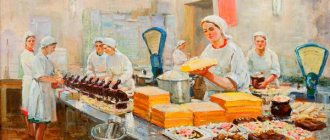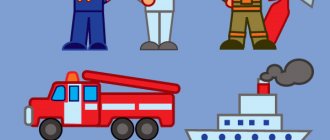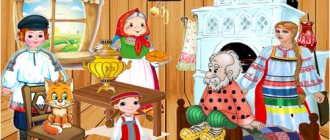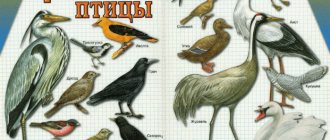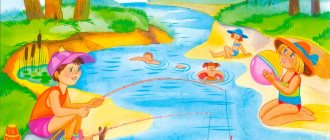Summary of a game lesson on speech development in the preparatory group on the topic: Dishes
Summary of educational activities for speech development on the topic: “Dishes”, through didactic games
Goal : Development and improvement of the child’s speech. Objectives: 1. Expand children’s understanding of the characteristic features of dishes.
2. Consolidate knowledge about dishes with children. 3. Enrich, clarify and activate the child’s vocabulary. 4. Clarify and consolidate the difference between tea, table and kitchen utensils. 5. Be able to coordinate numerals with nouns. 6. Develop the grammatical structure of speech when describing dishes. PROGRESS OF THE CLASS:
- Guys, guess my riddles: 1. Everything in me is seething, boiling, And it’s pouring from my nose.
To remove me from the stove, you will have to take me by the handle. (Children answer - teapot). 2. It is necessary for us, because we eat food from it. Deep and shallow They call her... (Plate) 3. I have two arms, a bottom instead of legs. Steam comes out from under the hat, it can get burned. (Pot). 4. If I’m empty, I forget about you, But when I’m carrying food, I won’t pass by my mouth. (Spoon). 5. We use it to cut meat, vegetables, sausages. If it is sharpened, it is easy and simple to cut with it. (Knife). 6. And pancakes, and an omelet, and potatoes for lunch, and pancakes - wow! It fries everything. (Frying pan) 7. If you want tea, choose any one! Here they are - fatties. Who are they? (Mugs). - Name all these items for me in one word... (dishes). - Guys, let’s figure it out with you, what kind of dishes are there and what they are used for? (Yes). - What is the name of the utensils in which we cook? (kitchen) - What is the name of the dishes from which we eat? (dining room) - What is the name of the dishes from which we drink tea or coffee? (tea room) - Now tell me the dishes, what they are, what they are made of. D/I “What kind of dishes”: The dishes are made of metal - what kind....? (metal) The dishes are made of wood, - what...? (wooden) The dishes are made of glass - what...? (glass) The dishes are made of plastic - what...? (plastic) - Well done, guys!! Now, let’s put the dishes in their places. D/I “Find a place for the dishes” (you need to put the set of dishes in their places: on the dining room table, in the kitchen cabinet, on the tea tray, while pronouncing all your actions) - Well done!! And now, I name the piece of utensils, and you say to me affectionately D/I “Say kindly”: Cup -... cup, Plate -... plate, Fork -... fork, Saucepan -... saucepan, and so on. - Great, guys! Next task, D/I “Find the extra dishes” and explain why. (from a set of cards, identify the extra item). - In front of you guys, patterns of dishes, your task is to guess which dishes are hidden D/I “Find the dishes.” - And now, guys, let’s try to describe the dishes according to the diagram that I will show you D/I “Describe the dishes.” (Several guys go out and write a descriptive story). D/I “Make a sentence” (from a set of words you need to make a sentence: cook, pan, ladle) and so on. - Guys, you are all great! And now we will create a collective work using colored paper using the mosaic appliqué method. - Look how great we did!!
We recommend watching:
Summary of an open lesson on speech development in a preparatory group Summary of an open lesson on speech development in a preparatory group Summary of an educational activity on speech development in a preparatory group on the topic: Friendship Summary of a lesson on speech development in a preparatory group of a kindergarten: A trip to the museum
Similar articles:
Summary of a lesson in kindergarten in the preparatory group “We are so different - boys and girls”
Dishes. Summary of a lesson on speech development for preschoolers
Municipal budgetary educational institution
of additional education for children Center for the Development of Creativity of Children and Youth "Levoberezhny" Lesson notes for children 4.5-5 years old
Subject "Speech Development" 1 year of study
"Dishes"
Additional education teacher Lyudmila Valerievna Zverintseva , Lipetsk, 2012 Lesson duration:
25 minutes.
Characteristics of the group of students:
- number – 15 people;
- age – 4.5-5 years;
- first year of study.
Form:
traditional activity.
Lesson topic :
“Dishes”
Goal:
consolidation in speech of a noun with the general word “dishes”
Objectives: educational:
expansion and specification of ideas about dishes, its purpose, the parts of which it consists, expansion of the dictionary on the topic ();
developing
: develop logical thinking, attention, memory
,
dialogic speech, speech breathing, visual attention.
educating:
developing cooperation skills, a positive attitude towards participation in class, listening without interrupting, initiative, independence, fostering a caring attitude towards things and household items.
Teaching methods:
guessing riddles
,
artistic reading, talking with children about issues, looking at pictures, word games, independent practical activities for children, lesson summary.
Equipment:
subject pictures on the topic: “Dishes”, cut plates, illustrations of K. Chukovsky’s fairy tales “Fedorino Grief”, “Moidodyr”.
Lesson plan:
- Organizing time:
(greeting, finger gymnastics, articulation gymnastics) – 7 min.
- Main part:
(guessing riddles, the game “What has changed”, the game “The Fourth Extra”, physical education, reading excerpts from K. Chukovsky’s fairy tales, talking with children about issues, the game “Assemble a cut plate”, the game “Name the action”) – 16 min.
- Lesson summary
(conversation) – 2 min.
Progress of the lesson:
- Organizing time.
Greetings. Hello, friends!
Today in the lesson you and I will help one grandmother, and we will find out what happened to her later... To get our tongue and fingers ready for the lesson, let's do some exercises for them. Finger gymnastics:
One, two, three, four, (We squeeze and unclench our palms one by one.) We washed the dishes: A teapot, a cup, a ladle, And a large ladle. (We bend our fingers one by one.) We washed the dishes, We only broke the cup, The ladle too fell apart, the nose of the teapot was knocked off, we broke the spoon a little.
This is how we helped mom. (Clap your hands.) Articulation gymnastics
1. “Clock.”
Stick out your narrow tongue. Reach your tongue alternately to the right ear, then to the left. Move your tongue from the corner of your mouth at a slow pace under the guidance of the speech therapist. Do 8 times 2. “Horse”. Suck your tongue to the roof of your mouth and click your tongue. Click slowly, firmly. Pull the hypoglossal ligament. Do 8 times. 3. "Swing". Stick out your narrow tongue. Reach your tongue alternately to your nose and then to your chin. Do not close your mouth. The exercise is carried out counting 8 times. 4. “Delicious jam.” Stick out your wide tongue, lick your upper lip and move your tongue deep into your mouth. Repeat 6 times 5. “Painter”. Stick out your tongue, open your mouth slightly. Lick first the upper, then the lower lip in a circle. Do this 6 times, changing direction. 2. Main part.
- Making riddles.
Teacher: Guys, look at the board. There are some strange pictures here. Let us guess the riddles, and if you answer correctly, the pictures will turn to us. The teapot's friend has two ears, cooks porridge and soup for Yulia. And her name is... Children: pan
As soon as he starts talking and talking, you need to make tea as soon as possible.
Children: a teapot
And for tea and yogurt, my friend, Substitute... Children:
a cup
It can be deep.
It can also be small. However, this is not a river. Children: plate
To fry food, We need... Children:
pan
I'm a ladle with holes, But I'm not bad.
I was like this from birth. Children: colander
Teacher: That's right! Well done! This is what the Posuda store turned out to be like. Oh, look, some items have changed places. Look carefully, tell me what has changed?
- Game "What has changed?"
(Children close their eyes, at this time the teacher swaps the pictures of dishes. Children guess what has changed.)
- Game "Four Wheel"
(The teacher names a number of words, the children say which word is superfluous, inappropriate)
- Pan, saucer, sausage, kettle
- Ladle, flatbread, fork, spoon
- Hooligan, glass, plate, knife
- Cup, herring, potato, eggplant
- Decanter, mug, girlfriend, saucer
- Frying pan, ladle, colonel, saucepan
- Plate, spoon, tray, vacuum cleaner
- Apple, lemon, jug, pear
- Physical exercise "Dishes"
Here is a large glass teapot, (Puff up your cheeks, put your hands on your hips.) Very important, like a boss. Here are the porcelain cups, (They stretched their arms up, palms up.) Very large, poor things. Here are the porcelain saucers, (Arms to the sides, palms down.) Just knock, they will break. Here are the silver spoons, (Jumping in place.) The head is on a thin leg. Here is a plastic tray, (Tilts left and right.) He brought us the dishes. Teacher: Listen carefully, guys, to what happened to one grandmother, whose name was Fedora.
- “Reading an excerpt from K.I. Chukovsky’s fairy tale “Fedorino’s grief”, “Moidodyr”
And the pan, as it ran, shouted to the iron: “I’m running, running, running, I can’t hold on!” So the teapot runs after the coffee pot, chattering, chattering, rattling... The irons run, clack, and jump over puddles, over puddles. And behind them are saucers, saucers - Ding-la-la! Ding-la-la! They rush along the street - Tink-la-la! Ding-la-la! They bump into glasses - ding! - and the glasses - ding! - break. And he runs, strums, knocks the frying pan: “Where are you going? Where? Where? Where? Where?" And behind her are forks, glasses and bottles, cups and spoons, galloping along the path. A table fell out of the window And went, went, went, went, went... And on it, and on it, Like on a horse, the samovar sits And shouts to his comrades: “Go away, run, save yourself!” And into the iron pipe: “Boo-boo-boo!
Boo Boo Boo!" I want to drink tea, I run up to the samovar, But the pot-bellied one ran away from me like from fire. God, God, what happened? Why did everything turn around, spin and rush like a wheel? Irons behind boots, Boots behind pies, Pies behind irons, Poker behind a sash - Everything is spinning, and spinning, and rushing head over heels.
- Conversation with children on:
— What happened to the dishes? - Why did she run away from Fedora? - Why did the dishes run away from the boy? — List what kind of dishes you heard in fairy tales? Teacher: Let's treat the dishes with care: don't hit them, help put them away, wash them, wipe them and place them neatly on the shelf. Let's help Grandma Fedora collect the plates.
- Game “Assemble a cut plate”
- Game "Name the action"
Kettle - boiling
From a plate - eating In a frying pan - frying In a saucepan - boiling 3. Summary of the lesson
- Conversation with children on issues
-What did we see in the Posuda store? -How should you treat kitchen items?
- Farewell to children
LIST OF REFERENCES USED:
- Volchkova V.N., Stepanova N.V. Lesson notes for the senior group of kindergarten. – Voronezh., “Teacher”., 2006.
- Knyazeva O.L. Introduction to the origins of Russian folk culture., St. Petersburg, 1997.
- Uzorova O.V., Nefedova E.A. Riddles for the development of speech, attention, memory and abstract thinking. - M., Astrel, 2005.
- Klyueva N.V. We teach children to communicate. Yaroslavl., 1996.
LiveInternetLiveInternet
- Registration
- Entrance
—Categories
- toys (580)
- tilde (223)
- soft toy (222)
- dolls (121)
- teddy bears (13)
- barbie (5)
- sewing (380)
- children (120)
- embroidery (261)
- magazines (108)
- knitting (188)
- knitting for mothers (55)
- knitting for girls and boys (23)
- napkins and blankets, pillows (7)
- magazines (6)
- elements (4)
- knitting for dads (3)
- bags (2)
- pet clothes (1)
- clipart (142)
- decoration (121)
- my home - everything for home decoration (117)
- from ribbons (116)
- patchwork (108)
- new year (96)
- scrapbooking (93)
- felt crafts (79)
- educational toys (74)
- decoupage (74)
- cooking (67)
- beads (66)
- polymer clay (63)
- activity with children (58)
- speech development (23)
- tasks (9)
- color, shape, size (3)
- no theme - handicraft (58)
- DIY furniture (52)
- felting (39)
- garden and vegetable garden (36)
- QUILING (32)
- my works (28)
- decoupage (11)
- cross stitch (8)
- tilde (3)
- in Photoshop (3)
- beads (2)
- wedding (1)
- wedding (25)
- create with children (23)
- photoshop (22)
- made of paper (16)
- clothing and shoes (13)
- from waste material (13)
- music (12)
- candy (9)
- gift decoration (6)
- beauty and health (5)
- soap making (4)
- candles (4)
- for diary (3)
- photo collections (3)
- children's literature (3)
- speech therapy (2)
- cinema (2)
- I'll change. (2)
- batik (2)
- newspaper weaving (1)
- sweets (1)
- for sale (0)
-Music
- All (2)
—Search by diary
—Subscription by e-mail
-Statistics
SPEECH DEVELOPMENT. LEXICAL TOPIC "TABLEWARE"
SPEECH DEVELOPMENT. LEXICAL TOPIC "TABLEWARE".
CHILDREN SHOULD KNOW THE NOUNS: cup, glass, goblet, plate, spoon, fork, knife, tank, pan, basin, dish, jar, meat grinder, bottle, can, bowl, grater, frying pan, jug, saucer, sugar bowl, teapot, coffee pot , bread box, butter dish. Creamer, mug, salt shaker, pepper shaker, sieve.
ADJECTIVES: clay, glass, wood, porcelain, enameled, metal, plastic, fragile, durable, tea, dining room, kitchen, sharp, dull, thick, thin, light, smooth, shiny, deep, clean, dirty, empty, full.
VERBS: wash, store, break, wipe, dry, pour, eat, cook, drink, rinse, pour, apply, cut, sift, fry, bake, cook, brew, boil, stew, chop.
CHILDREN SHOULD BE ABLE TO FORM ADJECTIVES: From porcelain - porcelain. Made of wood - wooden. Made of glass - glass. Made of clay - clay. Made of metal - metal. Made of plastic - plastic.
DESCRIBE THE TABLEWARE: What is it called? What colour? What shape? What size? What material is it made of? What parts does it consist of? (walls, bottom, lid, handles, spout) What are the dishes for?
COMPARE TABLEWARE Teapot - cup. Pan - plate. Jug - glass. Frying pan - spoon.
